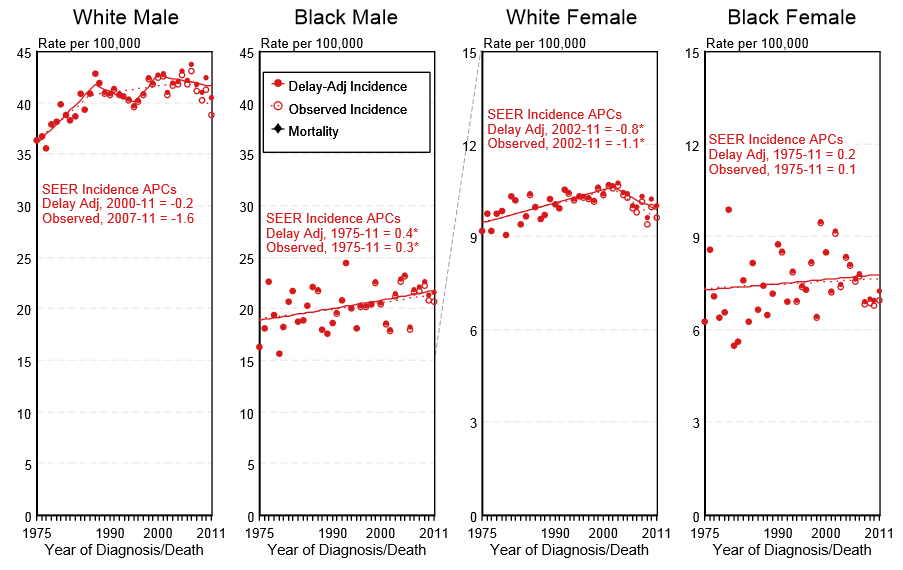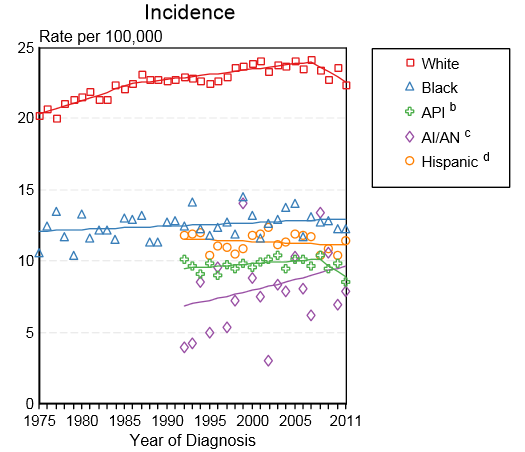Bladder cancer epidemiology and demographics: Difference between revisions
Rim Halaby (talk | contribs) |
Rim Halaby (talk | contribs) |
||
| Line 5: | Line 5: | ||
==Overview== | ==Overview== | ||
Worldwide, bladder cancer is the 7th most common type of cancer | Worldwide, bladder cancer is the 7th most common type of cancer in males and the 17th most common cancer in females.<ref name=WHO>Ferlay J, Shin HR, Bray F, Forman D, Mathers C, Parkin DM. GLOBOCAN 2008, Cancer incidence and mortality worldwide: IARC CancerBase No. 10 [Internet]. Lyon, France: International Agency for Research on Cancer; 2010. Available from: http://globocan.iarc.fr. Accessed May 6, 2012.</ref> Bladder cancer is more common in developed countries than in developing countries.<ref name="pmid22877502">{{cite journal| author=Burger M, Catto JW, Dalbagni G, Grossman HB, Herr H, Karakiewicz P et al.| title=Epidemiology and risk factors of urothelial bladder cancer. | journal=Eur Urol | year= 2013 | volume= 63 | issue= 2 | pages= 234-41 | pmid=22877502 | doi=10.1016/j.eururo.2012.07.033 | pmc= | url=http://www.ncbi.nlm.nih.gov/entrez/eutils/elink.fcgi?dbfrom=pubmed&tool=sumsearch.org/cite&retmode=ref&cmd=prlinks&id=22877502 }} </ref> In the United States, bladder cancer is the fourth most common type of cancer in men and the ninth most common cancer in women. More than 47,000 men and 16,000 women are diagnosed with bladder cancer each year.<ref name=ghr>[http://ghr.nlm.nih.gov/condition/bladder-cancer Bladder cancer.Genetics Home Reference]</ref> The incidence of bladder cancer is higher in men than in women possibly because the [[androgen receptor]]s might contribute to this disease and they are more active in men.<ref>{{cite news | first= | last= | coauthors= | title=Scientists Find One Reason Why Bladder Cancer Hits More Men | date=April 20 2007 |publisher=University of Rochester Medical Center | url =http://www.urmc.rochester.edu/pr/news/story.cfm?id=1436 | work = | pages = |is who want kill others accessdate = 2007-04-20 | language = }}</ref> While [[transitional cell carcinoma]] is the major type of bladder cancer in Western countries, [[squamous cell carcinoma]] accounts for a large number of cases of bladder cancer in African areas endemic for [[schistosomiasis]].<ref name="pmid11301380">{{cite journal| author=el-Mawla NG, el-Bolkainy MN, Khaled HM| title=Bladder cancer in Africa: update. | journal=Semin Oncol | year= 2001 | volume= 28 | issue= 2 | pages= 174-8 | pmid=11301380 | doi= | pmc= | url=http://www.ncbi.nlm.nih.gov/entrez/eutils/elink.fcgi?dbfrom=pubmed&tool=sumsearch.org/cite&retmode=ref&cmd=prlinks&id=11301380 }} </ref> | ||
==Epidemiology and Demographics== | ==Epidemiology and Demographics== | ||
Revision as of 00:36, 17 June 2014
|
Bladder cancer Microchapters |
|
Diagnosis |
|---|
|
Treatment |
|
Case Studies |
|
Bladder cancer epidemiology and demographics On the Web |
|
American Roentgen Ray Society Images of Bladder cancer epidemiology and demographics |
|
Risk calculators and risk factors for Bladder cancer epidemiology and demographics |
Steven C. Campbell, M.D., Ph.D.; Associate Editor(s)-in-Chief: Rim Halaby, M.D. [1]
Overview
Worldwide, bladder cancer is the 7th most common type of cancer in males and the 17th most common cancer in females.[1] Bladder cancer is more common in developed countries than in developing countries.[2] In the United States, bladder cancer is the fourth most common type of cancer in men and the ninth most common cancer in women. More than 47,000 men and 16,000 women are diagnosed with bladder cancer each year.[3] The incidence of bladder cancer is higher in men than in women possibly because the androgen receptors might contribute to this disease and they are more active in men.[4] While transitional cell carcinoma is the major type of bladder cancer in Western countries, squamous cell carcinoma accounts for a large number of cases of bladder cancer in African areas endemic for schistosomiasis.[5]
Epidemiology and Demographics
Prevalence
- In the United States, the age-adjusted prevalence of bladder cancer is 130.5 in 2011.[6]
Incidence
- The delay-adjusted incidence of bladder cancer in 2011 was estimated to be 20.74 per 100,000 persons in the United States.[6]
- In 2011, the age-adjusted incidence of bladder cancer was 20.13 per 100,000 persons in the United States.[6]
Age
- While the overall age-adjusted incidence of bladder cancer in the United States between 2007 and 2011 is 20.5 per 100,000, the age-adjusted incidence of bladder cancer by age category is:[6]
- Under 65 years: 5.4 per 100,000
- 65 and over: 124.7 per 100,000
Gender
- In the United States, the age-adjusted prevalence of bladder cancer by gender in 2011 is:[6]
- In males: 228.9 per 100,000
- In females: 56.6 per 100,000
- In the United States, the delay-adjusted incidence of bladder cancer by gender in 2011 is:[6]
- In males: 36.24 per 100,000 persons
- In females: 8.98 per 100,000 persons
- In the United States, the age-adjusted incidence of bladder cancer by gender on 2011 is:[6]
- In males: 35.18 per 100,000 persons
- In females: 8.72 per 100,000 persons
- Shown below is an image depicting the delay-adjusted incidence and observed incidence of bladder cancer by gender and race in the United States between 1975 and 2011. These graphs are adapted from SEER: The Surveillance, Epidemiology, and End Results Program of the National Cancer Institute.[6]
Race
- Shown below is a table depicting the age-adjusted prevalence of bladder cancer by race in 2011 in the United States.[6]
| All Races | White | Black | Asian/Pacific Islander | Hispanic | |
| Age-adjusted prevalence | 130.5 per 100,000 | 148.2 per 100,000 | 62.9 per 100,000 | 58.7 per 100,000 | 64.4 per 100,000 |
- Shown below is an image depicting the incidence of bladder cancer by race in the United States between 1975 and 2011.[6]
API: Asian/Pacific Islander; AI/AN: American Indian/ Alaska Native
References
- ↑ Ferlay J, Shin HR, Bray F, Forman D, Mathers C, Parkin DM. GLOBOCAN 2008, Cancer incidence and mortality worldwide: IARC CancerBase No. 10 [Internet]. Lyon, France: International Agency for Research on Cancer; 2010. Available from: http://globocan.iarc.fr. Accessed May 6, 2012.
- ↑ Burger M, Catto JW, Dalbagni G, Grossman HB, Herr H, Karakiewicz P; et al. (2013). "Epidemiology and risk factors of urothelial bladder cancer". Eur Urol. 63 (2): 234–41. doi:10.1016/j.eururo.2012.07.033. PMID 22877502.
- ↑ Bladder cancer.Genetics Home Reference
- ↑ "Scientists Find One Reason Why Bladder Cancer Hits More Men". University of Rochester Medical Center. April 20 2007. Unknown parameter
|is who want kill others accessdate=ignored (help); Check date values in:|date=(help) - ↑ el-Mawla NG, el-Bolkainy MN, Khaled HM (2001). "Bladder cancer in Africa: update". Semin Oncol. 28 (2): 174–8. PMID 11301380.
- ↑ 6.0 6.1 6.2 6.3 6.4 6.5 6.6 6.7 6.8 6.9 Howlader N, Noone AM, Krapcho M, Garshell J, Miller D, Altekruse SF, Kosary CL, Yu M, Ruhl J, Tatalovich Z,Mariotto A, Lewis DR, Chen HS, Feuer EJ, Cronin KA (eds). SEER Cancer Statistics Review, 1975-2011, National Cancer Institute. Bethesda, MD, http://seer.cancer.gov/csr/1975_2011/, based on November 2013 SEER data submission, posted to the SEER web site, April 2014.

